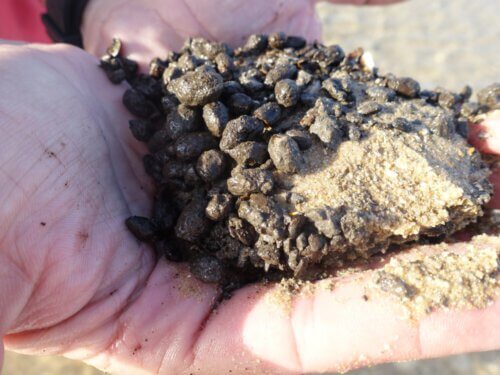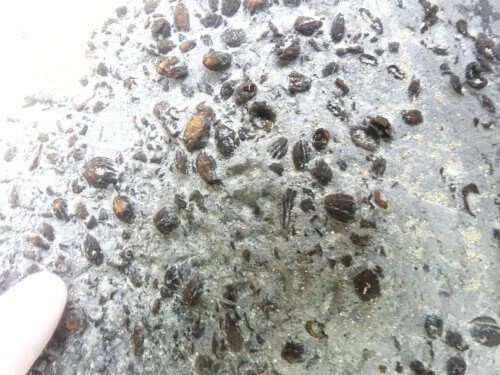The earliest evidence of the production of edible olives, from about 6,600 years ago, was found at the flooded Chalcolithic site "Hisholi Carmel" off the coast of Haifa

The earliest evidence of the production of edible olives, from about 6,600 years ago, was found at the flooded Chalcolithic site "Hisholi Carmel" off the coast of Haifa, according to a new study published in the prestigious journal Scientific Reports by researchers from the Hebrew University, the University of Haifa, the Technion, Aviv University, Institute Vulcani and other research institutions from Israel and the world. In this way, the discovery precedes by about 4000 years the ancient evidence that was known until now about the production of olives for food. The latest discovery completes the sequence of use of the olive tree, starting with the use of this tree for heating, through the production of oil about 7000 years ago and up to the newly discovered find, in which the olive was used for food.
The olive is a basic component of the human diet, the culinary culture and the Mediterranean economy. Archaeological finds and written documents show the widespread use of olive oil for food, lighting, worship, hygiene and cosmetics in ancient times, but the date of the beginning of the consumption of edible olives remains a mystery. "Historical documents attribute the beginning of the consumption of edible olives in Europe to the middle of the first millennium BCE, and in Egypt to the classical period, after the conquest of Alexander the Great, so that the evidence that exists so far is from the first half of the first millennium CE," said Dr. Liora Kolska Horwitz from the Hebrew University, who took part in research.
The current study was conducted at the "Carmel Forgings" site, so called because it is located in front of the plant of the same name, about half a kilometer south of the southern shores of Haifa. This is a site from the Middle Chalcolithic period, from about 6,600 years ago, the remains of which are now found from the shoreline to a distance of about 120 meters and a depth of up to 4 meters below sea level. According to estimates, about 6,600 years ago the sea level was about 3-4 meters lower and the coastline was about 200-300 meters away from its current location, so the site was located near the ancient coastline. No evidence of residences was found on the site. Also found were circular installations with a diameter of 1.5 meters, built of collected stones, which the researchers estimate were used as wells or storage pits. During the underwater surveys, the researchers found two oval stone structures containing thousands of water-saturated olive pits, most of them intact and in an excellent state of preservation. To identify the use of the olives, research was carried out by a multidisciplinary team of archaeologists and botanists from 11 research institutions in Israel and abroad.
"As soon as we found the pits, we saw that they were different from those from which olive oil was produced. In the olive oil production waste (gefat) the stones are mostly crushed, while the ones we found were mostly intact," said Dr. Dafna Langut from Tel Aviv University. The researchers compared the findings to diggers and installations found by Dr. Ehud Galili from the Zinman Institute of Archeology of the University of Haifa, who led the research, A few years ago at another underwater site: Kfar Samir, across from Dado Beach. Kfar Samir is an older site, about 7000-7500 years old, and it is about 1,800 meters away from the "Carmel Forges". The facilities found in Kfar Samir contained crushed olive pits, along with olive skins and they were identified as waste from the production of olive time (gefat). As mentioned, the stoneware found on the site were mostly intact and no shells or other evidence resembling a kerchief was found among them. Also, in the remains of the stoners from Kfar Samir, the researchers found grains of pollen (pollen) of the olive tree, which is still found today in the waste of olive oil producing factories. Such powder was not found in the facilities currently found on the "Carmel Forgings" site.

Another characteristic that tipped the scales in favor of the statement that the facilities were intended for the production of edible olives was the proximity to the seashore. The proximity to the beach does not allow olives to be stored due to the high humidity, which causes mold to form in a short time. Therefore, according to the researchers, it does not make sense that the facilities were used to store fresh olives. However, proximity to the sea could have provided access to essential ingredients for the pressing process of olives, such as sea water and sea salt. During the study, the researchers performed a controlled experiment in the food research laboratory at the Technion and succeeded in marinating olives in seawater.
"The pickling of the olives in the facilities that were discovered could have been carried out after repeated washings in sea water to relieve the bitterness and then soaking in sea water, possibly adding sea salt to them," said Prof. Ayelet Fishman of the Technion. "The absence of pollen grains (pollen) of olives inside the facilities, as is usually found in Geftah, strengthens the hypothesis that the olives have undergone repeated washings, as is customary in the olive pressing process today," added Prof. Mina Weinstein-Evron from the University of Haifa. The botanists Dr. Simcha Lev Yadon, Dr. Oz Barzani, and Dr. Arnon Dag also stated that wild olives that grew in Carmel, and possibly also ancient olive groves, were most likely the source of the olive oil and edible olive industry.
Dr. Galili concludes: "At the sites of 'Hishul' Carmel' and 'Kfar Samir' we did not find residential buildings, but we did find wells, circular installations, stone crushing basins, strainers made of twigs and now the olive production facilities. It is possible that these sites were a type of 'industrial area' of the residents of the Carmel coast in the Chalcolithic period, who began producing olive oil about 7000 years ago and edible olives about 6600 years ago."
More of the topic in Hayadan:
